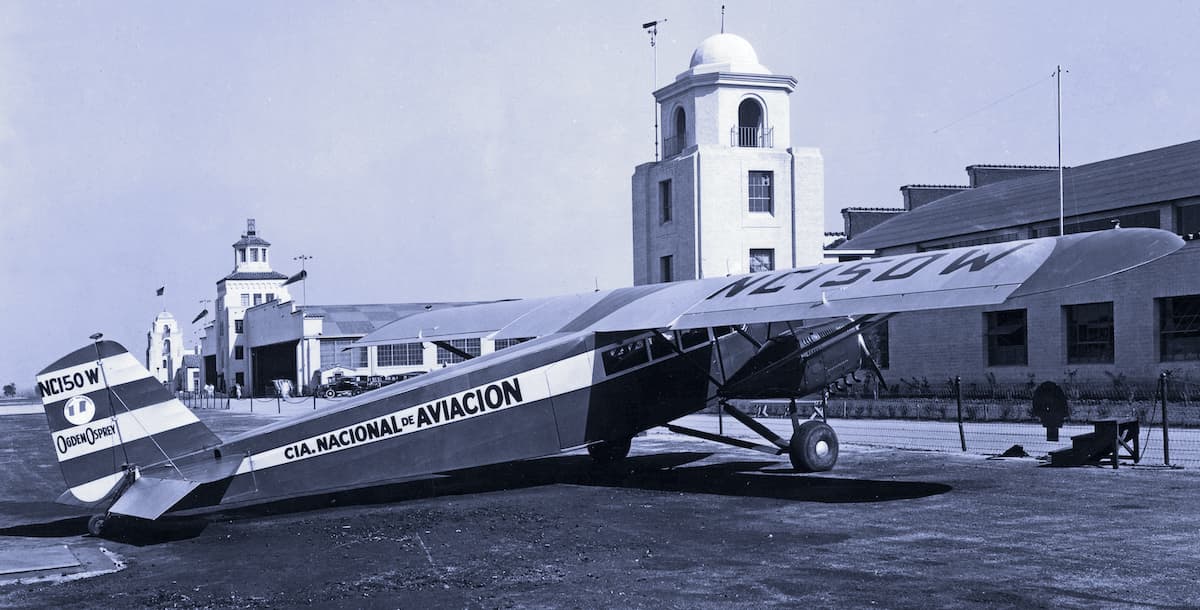
It’s a story retold many times about aircraft manufacturers that blossomed post-Lindbergh, only to succumb to the financial battering of the Depression following 1929’s stock market crash.
That’s what happened with the Ogden Aeronautical Corporation, which came into being in May 1929 in Inglewood, California.
A principal in the company was test pilot Henry H. Ogden who, a half-decade earlier, made a name for himself as one of the plucky Army fliers who performed the first round-the-world flight in Douglas World Cruiser biplanes.
The Cruiser Boston flown by Ogden, as enlisted copilot/flight mechanic, with pilot Lt. Leigh Wade, was lost in the Atlantic during the epic adventure. Wade and Ogden were rescued, and each hammered out successful aviation careers in the decades that followed.
Ogden Aeronautical Corporation’s 5,000-square-foot shop seems small by today’s standards, but in 1929 the Ogden team envisioned a monthly rollout of a new Ogden Osprey monoplane trimotor from the facility.

The Osprey sought a niche as a small six-place trimotor suitable as a business aircraft, a feeder, or air taxi vehicle.
The Osprey briefly embraced a trio of air-cooled five-cylinder Kinner K5 engines, each delivering between 90 to 100 horsepower. But soon the Osprey switched to a set of three 90-horsepower Cirrus inline air-cooled engines that were housed in elongated flat-sided nacelles.

Later, 95 (and up to 125) horsepower Menasco four-cylinder inline air-cooled engines were used in the Osprey’s brief life.

The Osprey incorporated a masterful baffle design that directed incoming air around the nacelle to cool all four inline engine cylinders uniformly, while heated air exited to the rear.
The choice to make such a diminutive airplane a trimotor was appealing at a time when engine-out safety was a selling point. The Osprey was said to fly well on two engines, and could still perform, albeit sluggishly, on one engine while the pilot vectored to a landing spot.
The Osprey had a wingspan of only 50 feet and a length of 34 feet, 6 inches. The Osprey had a useful load of 1,650 pounds. With one pilot and 90 gallons of gas, useful load was 900 pounds, or 735 pounds with two pilots, according to historian Joseph Juptner. The Ogden Osprey topped out at 128 miles per hour, and cruised at 102.
Welded steel tube formed the fuselage, with wooden fairings and fabric covering. The wooden wing featured a center section and two outer panels incorporating spruce and mahogany.

Ample insulation and soundproofing of the cabin made for comfortable conversation levels. Welded tube frame seats were fitted with wicker and leather trim, and the cabin interior was finished in high-quality fabric befitting the Osprey’s potential business customers. A small lavatory was located in the rear of the cabin. The cabin seats could be readily removed to accommodate freight.
Windows were shatterproof glass, and the pilots could open theirs by rolling them down. Metal propellers, Eclipse hand crank starters, Bendix brakes, and navigation lights came standard with the Osprey, as did a steerable swiveling tailwheel in an era not far removed from tailskids and grass airfields.

A throwover control wheel could serve either of the two cockpit pilot positions. A braking lever mounted between the pilots’ seats applied the intended amount of brake tension, while the rudder pedals delivered braking action to one or both wheels as needed.
This little trimotor started with a sticker price of $18,900, lowered to $16,000 in May 1931.
Records indicate only about six Ogden Ospreys were built. One found utility as a flying loudspeaker platform for advertising. By 1933, Henry Ogden was offering four Ospreys and spare parts in a reduced-price package deal that foretold the end of the Ogden Aeronautical Corporation adventure.

The 1920s saw a rotating game of musical chairs in aviation as designers, pilots, and entrepreneurs left companies to form new endeavors and alliances.
Henry Ogden had been the test pilot at Kreutzer Aircraft during that company’s Air Coach trimotor development. After he left Kreutzer, the kernel of a new trimotor helped launch the Ogden company.
The designer at Ogden was Frederick G. Thearle, who previously worked with pioneer Otto Timm, designer of several aircraft, innovator of a winning race plane, and subsequent builder of the Timm N2T trainer for the U.S. Navy.
Henry Ogden died in Laguna Niguel in southern California in January 1986 at the age of 85. In the decades between his participation in the round-the-world flight of 1924 and his death, Ogden operated a shuttle carrier between Palm Springs and destinations in Baja California, before joining Lockheed to lead the company’s facility in the United Kingdom that assembled and prepared Lockheed aircraft for European combat in World War II.
He retired from Lockheed in 1965 as the aerospace company’s vice president in charge of airplane servicing.
